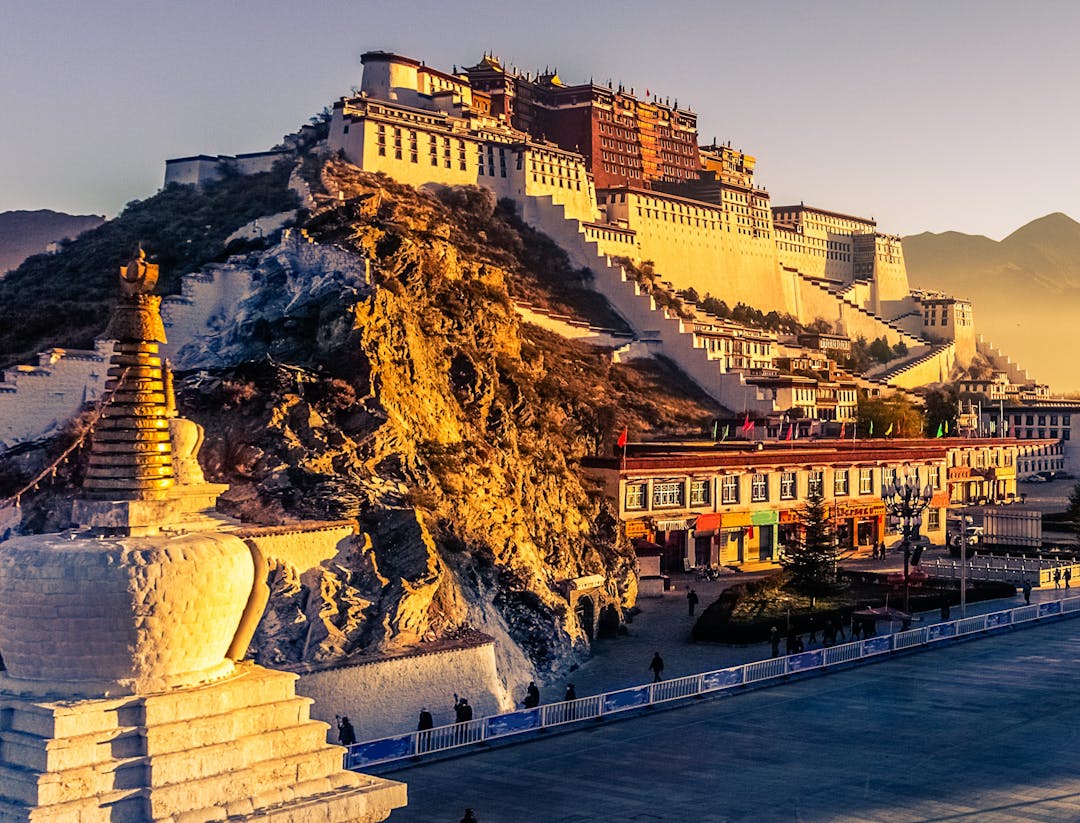About Tibet
Situated on the Tibetan Plateau irrigated by the Brahmaputra River, Tibet is known for its authentic and traditional practice of Tibetan Buddhism. With an average elevation of 4500 meters, Tibet is also called The Roof of the World. Officially an autonomous state of China, Tibet is known to the border with the Great Himalayan Range to the south.
Key Facts
- Location
Tibet lies in Eastern Asia to the southwest of China. It is located on the south-west part of China and borders India, Nepal, Burma, and Bhutan. - Geography
Tibet is one of the highest regions in the world with an average altitude of around 4500 meters. The Tibetan Plateau covers most of the Tibet whereas the southern part of Tibet shares its boundaries with some of the highest mountains in the world including the Mt. Everest (8848m). There is also Lake Region in the west and North West along with River region in East South and West. - Capital
The capital of Tibet is Lhasa and it is also the largest city. - Area
Tibet covers the total area of 1,228,400 sq. km. - Population
As of December 2014, the total population of Tibet Autonomous Region was announced as 3,180,000. However, UNPO has estimated the population of Tibet to be about 6 million Tibetans and 7.5 million Chinese settlers. - Political System
His Holiness the Dalai Lama is both the political and spiritual leader of Tibet. There have been political differences regarding Tibet and its independence from China between them. China claims Tibet to be its autonomous state whereas Tibetan government-in-exile states Tibet to be an independent state under unlawful occupation. - Major religion
The population of Tibet has been traditionally practicing ancient Tibetan Buddhism which is a mix of Bon and Buddhism. - Time Zone
Tibet follows the China Standard Time (GMT+8) since there is no other official time zone. - Official Language
Tibetan is the official language in Tibet and is widely used in here along with Chinese. - Electricity
The standard voltage used in Tibet is 220v supported mostly by hydropower.
Visa Information
For foreigners traveling to Tibet, you must either procure a Chinese Visa or Tibet Group Visa. The China Visa can be obtained from the Chinese Embassy in foreign countries; however, the Group Visa is only issued from the Chinese Embassy in Kathmandu. You must also obtain a Tibet Travel Permit (TTP) to travel around Tibet. The TTP permit should be applied for 15 days before the travel and it required the China Visa documents as well.
How to reach
There are two major ways to enter Tibet: via land and air. Similarly, China and Nepal are the only destinations from where travelers enter Tibet. From Nepal, you can travel to Tibet with a direct flight to Lhasa or by bus from the Sino-Nepal border. Another option of travel is through China. Qinghai-Tibet Railway is the cheapest route or you can take the train from other cities of China i.e. Beijing, Xining, Shanghai, Chengdu, Guangzhou. You can also decide to take a flight from Beijing, Shanghai or Chengdu.
Popular destinations to visit
Lhasa, the capital of Tibet is the most popular destinations to visit while in Tibet. The Potala Palace (Palace of Art), Jokhang Temple (The spiritual center of Tibet), Norbulingka (Summer Palace of Dalai Lama), Tashi Lhunpo Monastery (The largest monastery in Tibet) are the cultural attraction aroundLhasa. For trekkers and hikers, Namtso (Heavenly Lake), Yamdrok Lake (Sacred Lake), Yarlung Tsangpo Grand Canyon, Everest Base Camp, Mt. Kailash (6636m), Lulang Forest are some of the most popular attractions in Tibet.
Internet and Communication in the country
An Internet connection and other communication networks relativelydecent in Tibet. Internet cafes and Wi-Fi offer internet connectivity whereas cellular network is also a reliable option for internet and communication. However, social media sites like Facebook, Viber, and Twitter are banned in the country. So, travelers must install VPN applications before entering Tibet to use such sites.
Local Currency and Foreign Exchange
Renminbi (RMB) or Chinese Yuan is the official currency of Tibet and its exchange facilities are only supported by China or some upscale hotels in Tibet. Only a few places are found in Lhasa where you can exchange the foreign currency into local currency. You can also exchange your currency into Chinese Yuan in Nepal before you head to Tibet.
Weather and Climate
The climate of Tibet is known to be generally dry. Tibet also sees very little rainfall since the Himalayas act as the barrier for monsoon rain. Seasonal variation is minimumso, the weather is generally cold and dry. Thus, travelers must pack accordingly when they travel around Tibet.
People, Culture, and Festivals
Mostly, only Tibetan people are found in Tibet along with some Chinese, Chinese Muslims, Monba, Lhoba, and other minor nationalities. Most of these people follow Tibetan Buddhism along with a few following Islam, Hinduism,and Christianity.Lhosar (Tibetan New Year), Smom-Lam, Tsong-Kha-pa are some of the festivals celebrated by Tibetans.

